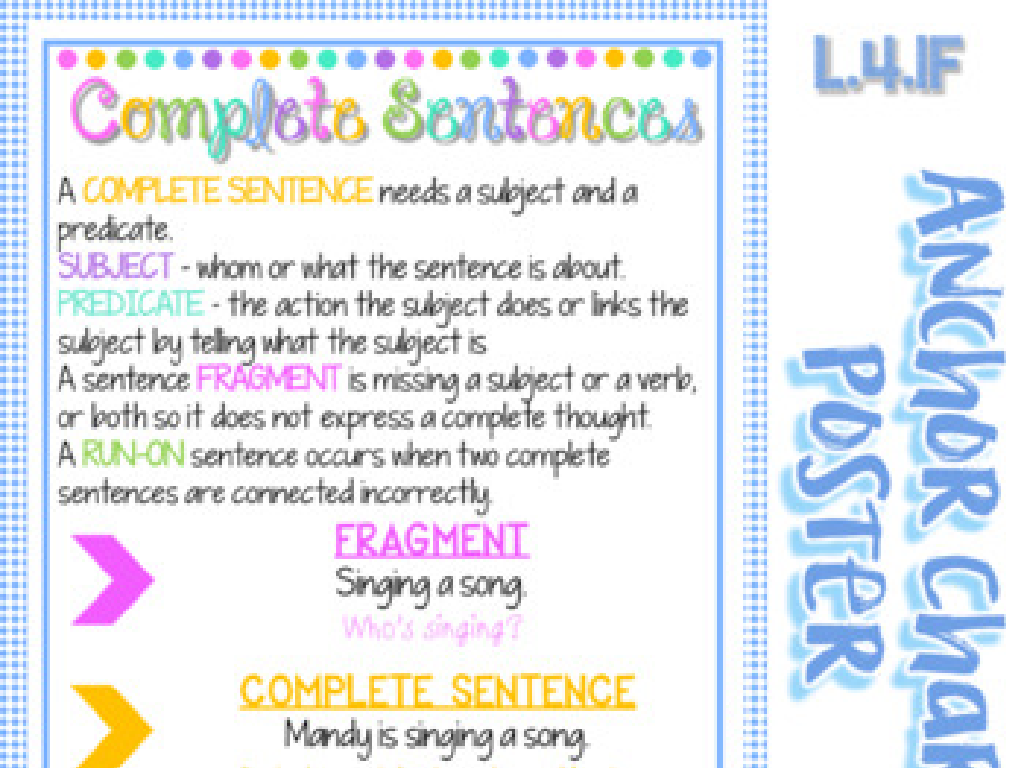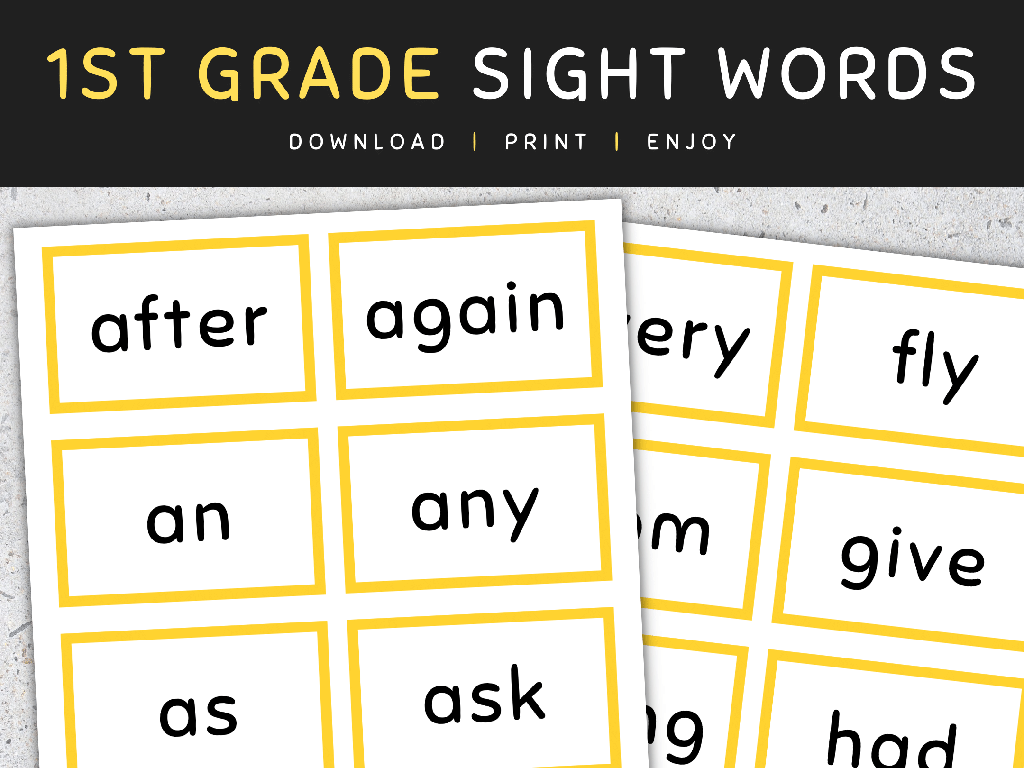Identify Rectangles
Subject: Math
Grade: Third grade
Topic: Quadrilaterals
Please LOG IN to download the presentation. Access is available to registered users only.
View More Content
Welcome to Quadrilaterals: Meet the Rectangle
– What is a quadrilateral?
– It’s a shape with four straight sides!
– Quadrilaterals have four sides
– Rectangles are special quadrilaterals
– Rectangles have 4 sides and 4 right angles
– Identifying rectangles around us
– Look for rectangles in the classroom like the door or books
|
Begin the lesson by engaging students with the question about quadrilaterals to assess their prior knowledge. Explain that quadrilaterals are four-sided shapes, setting the stage for introducing rectangles. Emphasize that rectangles are a type of quadrilateral with four right angles. Encourage students to identify and share examples of rectangles they see in the classroom or at home. This will help them connect the concept to real-world objects, making the lesson more tangible and memorable. Prepare to show visual aids or have physical examples of rectangles to support visual learners.
What is a Rectangle?
– A rectangle is a quadrilateral
– Four sides with right angles
– Each angle is 90 degrees
– Opposite sides are equal
– Like the sides of a book
– Rectangles in everyday objects
– Doors, books, and screens
|
This slide introduces the basic concept of a rectangle to third-grade students. Emphasize that a rectangle is a special type of quadrilateral, which is a four-sided shape. Highlight that rectangles have four right angles, which means each angle is 90 degrees. Explain that the opposite sides of a rectangle are the same length, using relatable examples such as the sides of a book or a door. Encourage students to identify rectangles in the classroom or at home to connect the concept with real-life objects. This will help them recognize rectangles and understand their properties in a tangible way.
Properties of Rectangles
– All angles are right angles
– Each corner of a rectangle makes a square ‘L’ shape
– Opposite sides are parallel
– Sides facing each other are always straight and never meet
– Opposite sides are equal length
– Measure the sides; they are the same across from each other
|
This slide introduces students to the fundamental properties that define a rectangle. Emphasize that all four angles in a rectangle are right angles, which means they are all 90 degrees. Show them how to identify parallel lines and explain that in rectangles, the sides across from each other are always parallel. Also, highlight that not only are these sides parallel, but they are also of equal length. Use visuals like a picture of a rectangle to point out these properties. You can bring a ruler and a square to demonstrate measuring angles and sides. Encourage students to look for rectangles in the classroom or at home as a practical exercise.
Identifying Rectangles
– Spotting rectangles among shapes
– Recall rectangle’s special properties
– Rectangles have 4 sides and 4 right angles
– Practice with a shapes group
– Find and point out rectangles in a mixed set
– Recognize rectangles confidently
|
This slide is aimed at helping third-grade students identify rectangles among various shapes. Start by revisiting the properties of rectangles that were previously learned, such as having four sides and four right angles. Encourage the students to look for these specific characteristics when distinguishing rectangles from other shapes. Provide a group of different shapes and have the students practice by picking out the rectangles. This activity will reinforce their understanding and help them recognize rectangles with confidence. As an extension, you can ask students to explain why a certain shape is or isn’t a rectangle, further solidifying their comprehension.
Finding Rectangles Around Us
– Rectangles in our world
– Classroom rectangle hunt
– Can you spot any rectangle-shaped objects here?
– Common rectangle examples
– Books, doors, and tablets are rectangles.
– Recognizing rectangles
– Look for opposite sides equal and four right angles.
|
This slide is designed to help students identify rectangles in their everyday environment, reinforcing the concept that this shape is not just a mathematical figure but also a part of their daily lives. Encourage the students to look around the classroom and identify objects that have the characteristics of a rectangle – opposite sides that are equal and four right angles. Provide examples such as books, doors, and tablets to get them started. This activity will help them to better understand the properties of rectangles and how to recognize them. It’s a practical exercise that combines visual learning with physical movement, making the lesson engaging and memorable.
Drawing Rectangles Step by Step
– Start with two horizontal lines
– Make sure lines are the same length
– Draw two vertical lines to connect
– Connect ends of horizontal lines
– Ensure all angles are right angles
– Use a square to check the angles
|
This slide is designed to teach third-grade students the process of drawing a rectangle. Begin by explaining that a rectangle is a type of quadrilateral with opposite sides that are equal and all angles that are right angles. Demonstrate on the board or using a document camera how to draw two horizontal lines of the same length. Emphasize the importance of precision in making sure the lines are equal. Next, show how to draw two vertical lines connecting the ends of the horizontal lines to complete the rectangle. Remind students to check that each corner forms a right angle, possibly using a square or a right-angle tool. Encourage students to practice drawing rectangles both on paper and using digital drawing tools if available. Provide individual assistance as needed and consider pairing students for peer support.
Class Activity: Rectangle Hunt
– Let’s find rectangles together!
– Explore the classroom on a ‘Rectangle Hunt’
– Work with a buddy to make a list
– Look for doors, books, and windows
– How many rectangles can you find?
|
This activity is designed to help students apply their knowledge of rectangles to the real world by identifying rectangle-shaped objects in their immediate environment. Have the students pair up to encourage teamwork. Provide them with a clipboard and paper to record their findings. As they search the classroom, guide them to consider objects like books, doors, windows, and tablets. After the hunt, regroup and discuss the objects found, emphasizing the properties of rectangles. This will reinforce their understanding of quadrilaterals and shapes in a fun, interactive way. Possible variations of the activity could include finding the largest rectangle, the smallest rectangle, or categorizing the rectangles by function.
Great Work on Rectangles!
– Celebrating our rectangle discovery
– Rectangles: four sides, four right angles
– Each angle in a rectangle is 90 degrees
– Spot rectangles in your home
– Look for rectangle shapes in everyday objects
– Share your rectangle finds tomorrow
|
This slide is meant to wrap up the lesson on rectangles, reinforcing the key characteristics that define them. It’s important to praise the students for their efforts in class today. Remind them that rectangles are a type of quadrilateral with four sides and four right angles, which makes each angle 90 degrees. Encourage them to continue their learning outside of the classroom by observing their surroundings at home and identifying objects that have a rectangular shape. This will help solidify their understanding of shapes in a real-world context. Ask them to come prepared to share at least one object they found to be a rectangle, fostering a sense of excitement and participation for the next class.






